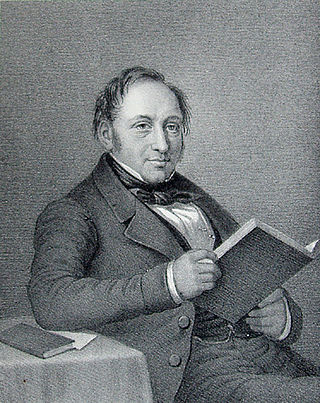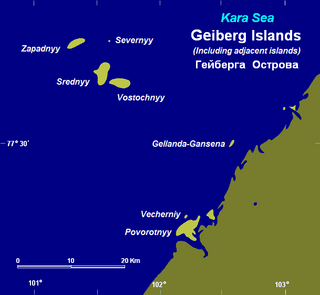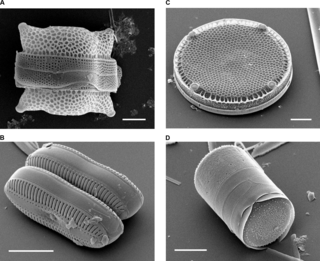
Diatomic molecules are molecules composed of only two atoms, of the same or different chemical elements. If a diatomic molecule consists of two atoms of the same element, such as hydrogen or oxygen, then it is said to be homonuclear. Otherwise, if a diatomic molecule consists of two different atoms, such as carbon monoxide or nitric oxide, the molecule is said to be heteronuclear. The bond in a homonuclear diatomic molecule is non-polar.

A diatom is any member of a large group comprising several genera of algae, specifically microalgae, found in the oceans, waterways and soils of the world. Living diatoms make up a significant portion of the Earth's biomass: they generate about 20 to 50 percent of the oxygen produced on the planet each year, take in over 6.7 billion tonnes of silicon each year from the waters in which they live, and constitute nearly half of the organic material found in the oceans. The shells of dead diatoms can reach as much as a half-mile deep on the ocean floor, and the entire Amazon basin is fertilized annually by 27 million tons of diatom shell dust transported by transatlantic winds from the African Sahara, much of it from the Bodélé Depression, which was once made up of a system of fresh-water lakes.

Corinna or Korinna was an ancient Greek lyric poet from Tanagra in Boeotia. Although ancient sources portray her as a contemporary of Pindar, not all modern scholars accept the accuracy of this tradition. When she lived has been the subject of much debate since the early twentieth century, proposed dates ranging from the beginning of the fifth century to the late third century BC.

Diatomaceous earth, diatomite, celite or kieselgur/kieselguhr is a naturally occurring, soft, siliceous sedimentary rock that can be crumbled into a fine white to off-white powder. It has a particle size ranging from more than 3 mm to less than 1 μm, but typically 10 to 200 μm. Depending on the granularity, this powder can have an abrasive feel, similar to pumice powder, and has a low density as a result of its high porosity. The typical chemical composition of oven-dried diatomaceous earth is 80–90% silica, with 2–4% alumina, and 0.5–2% iron oxide.

Axel Heiberg Island is an uninhabited island in the Qikiqtaaluk Region, Nunavut, Canada. Located in the Arctic Ocean, it is the 32nd largest island in the world and Canada's seventh largest island. According to Statistics Canada, it has an area of 43,178 km2 (16,671 sq mi). It is named after Axel Heiberg.

The Axel Heiberg Glacier in Antarctica is a valley glacier, 30 nautical miles long, descending from the high elevations of the Antarctic Plateau into the Ross Ice Shelf between the Herbert Range and Mount Don Pedro Christophersen in the Queen Maud Mountains.

Johanne Luise Heiberg was a Danish actress of the 19th century. She is most famous for her work at the Royal Theatre in Copenhagen, where she achieved great success. Though she was closely connected to the romantic tradition, Heiberg is still regarded as a key figure of Danish drama. She contributed to the growing public social and moral perception of Danish actors as artists and cultural personalities rather than simply performers.

Johan Ludvig Heiberg, Danish poet, playwright, literary critic, literary historian son of the political writer Peter Andreas Heiberg (1758–1841), and of the novelist, afterwards the Baroness Gyllembourg-Ehrensvärd, was born in Copenhagen. He promoted Hegelian philosophy and introduced vaudeville to Denmark.

Gunnar Edvard Rode Heiberg was a Norwegian poet, playwright, journalist and theatre critic.
Corinna or Korinna was an ancient Greek lyric poet.

The Coscinodiscophyceae are a class(s) of diatoms. They are similar to the Centrales, a traditional, paraphyletic subdivision of the heterokont algae known as diatoms. The order is named for the shape of the cell walls of centric diatoms, which are circular or ellipsoid in valve view. The valves often bear radially symmetrical ornamental patterns that can appear as dots when viewed with an optical microscope. Some also bear spines on their valves, which may either increase cell surface area and reduce sinking, or act as a deterrent to zooplankton grazers. Unlike pennate diatoms, centric diatoms never have a raphe.

The Heiberg Islands, spelt Geyberg, Gejberg or Geiberg is a group of four small islands covered with tundra vegetation and with scattered stones on their shores. They lie in the Kara Sea, between the bleak coast of Siberia's Taymyr Peninsula and Severnaya Zemlya. These islands are between 35 and 45 km from the continental shore.

A frustule is the hard and porous cell wall or external layer of diatoms. The frustule is composed almost purely of silica, made from silicic acid, and is coated with a layer of organic substance, which was referred to in the early literature on diatoms as pectin, a fiber most commonly found in cell walls of plants. This layer is actually composed of several types of polysaccharides.
The Geodetic Hills are a mountain range on central Axel Heiberg Island, Nunavut, Canada. It is associated with the Arctic Cordillera mountain system.

Corinna Dentoni is a former tennis player with a highest career ranking of 132 in the singles category as well as a tennis influencer.

Kirsten Heiberg was a Norwegian/German actress and singer who had a major film career in Germany between 1938 and 1954. She reached the peak of her career in 1942–43, performing in Joseph Goebbels' version of Titanic. After the war she was given a two-year ban by the Allies due to her role in the Nazi propaganda. In Norway she was never punished, as she was a German citizen.

Jean Hjalmar Dahl Heiberg was a Norwegian painter, sculptor, designer and art professor.
Svend O. Heiberg Memorial Forest is a 3,800-acre (1,500-hectare) research forest located in parts of Onondaga and Cortland counties, and within the towns of Truxton, Preble, Fabius, and Tully in New York State. Originally Tully Experimental Forest, the forest was renamed in 1965 after Svend O. Heiberg, former Associate Dean of Graduate Studies at the New York State College of Forestry at Syracuse University, in Syracuse, New York.

Hemiaulaceae is a diatom family. Species live between -1.86 and 29.47 degrees Celsius and at depths of up to 2010 meters.

Corinna Miazga was a German politician. Representing Alternative for Germany (AfD), Miazga served as a member of the Bundestag from the state of Bavaria from 2017 until her death in 2023.
















